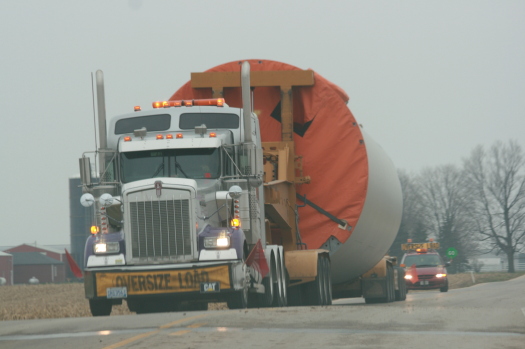Entries in rock county (6)
1/18/11 Hot off the Press! Walker's Bill AND But they said it would be only as loud as a refrigerator AND Wind developers: Do they have what it takes to take what you have? Unless Walker's bill passes, the answer is yes AND from our "What the ---" department: Anti-local government wind lobbyist spins Walker bill as anti-local government
Click on the images above to hear the sound of wind turbines in DeKalb County, IL. The top video was recorded yesterday.
Who is losing sleep because of wind turbine noise? The video above was shot from the home of this family.

This is the family, these are the children now living with the noise from poorly sited industrial turbines. You can read about what has happened to their lives since the turbines went on line by CLICKING HERE to visit their website
Note from the BPWI research nerd: While the 1800 foot setback from property lines proposed in Governor Walker's bill will not solve the the problem of wind turbine noise or shadow flicker it will provide much more protection for Wisconsin residents than the PSC's recent adoption of wind-developer-friendly rules, and make it more difficult for developers to site projects without the consent of the people who will be living with the turbines.
This is why wind developers and national and local lobbyists are pushing hard to make sure this bill does not pass.
WHAT YOU CAN DO RIGHT NOW TO PROTECT PROPERTY RIGHTS IN THE BADGER STATE
Please support Governor Walker's effort to increase industrial wind turbine setbacks to 1800 feet from from property lines. This setback will protect your right to build and plant trees on your land.
Current PSC rules allow turbines to be as close as 410 feet from your property line. They also prohibit you from building anything within 1250 feet of a wind turbine located on your neighbor's property. This turns portions of your land into a no-build and no-tree zone even though the turbine is not on your property. Some have long argued that this constitutes a 'taking' of your property.
Without the wind company's permission, one family in the We Energies Blue Sky Green Field wind project in Fond du Lac County can't build a long-planned attached garage onto their home because of wind turbines on their neighbor's farmland. Families who intended to build on their own land or add onto their homes are not be able to do so because of turbines located just 400 feet from their property lines.
A wind developer prospecting in Rock County expressed his feelings about impact to non participating property owners this way: "There are always winners and losers in any project."
Better Plan encourages you to contact Governor Walker's office to thank him for including a more protective setback in this proposed bill than that created by the Public Service Commission. We also urge you to contact your senator and representative right away to ask them to support this important bill.
CONTACT Governor Scott Walker govgeneral@wisconsin.gov
115 East Capitol
Madison WI 53702
(608) 266-1212CONTACT Legislators
Who Are My Legislators? To find out, CLICK HERE
From our "What the ---? department:

“This unreasonable proposal is a steamroller driven by anti-wind special interests, like realtors, bent on denying local governments the ability to decide what’s in their best interests,” said Vickerman.-
SOURCE: Alternative Energy Press Releases
Michael Vickerman worked hard to help pass a bill which stipped all local government in our state of the power to enact ordinances regulating wind siting in their communities and also overturned local wind ordinances. He is a PSC appointed member of Wisconsin's Wind Siting Council and in 2010 was a registered and paid lobbyist for RENEW Wisconsin whose clients include Alliant Energy, ATC, We Energies, MG&E, North American Hydro, WPPI, and major wind developers such as Invenergy, EnXco, Horizon Wind, Emerging Energies and other wind developers with projects pending in our state. [SOURCE]-
UPDATE: Although registered as a lobbyist in the past, Mr. Vickerman's name does not appear on the most recent list of 2011 lobbyists for RENEW Wisconsin. CLICK HERE FOR SOURCE
Here's the most recent press release written by Michael Vickerman
RENEW Wisconsin: Walker’s wind siting proposal strips local control
1/18/2011
More information
Michael Vickerman
Executive Director
608.255.4044
mvickerman@renewwisconsin.org
Mandating by statute an extreme setback distance for commercial wind turbines, Governor Scott Walker’s wind siting proposal would strip local governments of their ability to negotiate lesser setback distances with wind developers, according to RENEW Wisconsin, a statewide renewable energy advocacy group.
Walker’s proposal would require a setback distance between a turbine and neighboring property line of 1,800 feet, which can be shortened only by an agreement between the project owner and owners of adjoining properties, entirely bypassing towns and counties.
Walker’s proposal would eliminate the ability of local governments to attract wind developments that would generate revenues in lieu of taxes to help buffer the expected cuts to local governments in the upcoming state budget.
A story in the Fond du Lac Reporter on January 12 quoted town and county officials as saying the wind project revenue helped save on property taxes by filling the gap between rising municipal expenses and declining state-paid shared revenue dollars.
“We’ve seen five towns in Fond du Lac and Dodge counties enter into joint development agreements specifying reasonable setback distances because town officials wanted to capture the economic benefits of hosting wind projects larger than 50 megawatts,” Vickerman said.
The statewide siting rule, approved by the Public Service Commission (PSC) and set to take effect March 1, preserved local government authority to specify less restrictive conditions. “This unreasonable proposal is a steamroller driven by anti-wind special interests, like realtors, bent on denying local governments the ability to decide what’s in their best interests,” said Vickerman.SOURCE: http://wispolitics.com/index.iml?Article=223600
How big are those blades again? CLICK ON the image below to see turbine blades being transported by train.
EXTRA CREDIT READING:
Where is Ex-Governor Doyle working now?
AND.... Extra credit question: WHY ARE GOLDWIND EMPLOYEES DANCING IN A CHINESE WIND FARM? COULD IT BE THE U.S. STIMULUS DOLLARS? To read more about it, CLICK HERE
10/4/10 A picture of a 500 foot turbine is worth 1000 words: Fifty story turbines go up in Town of Glenmore, Brown County, Wisconsin AND Rock County wind farm plans scrapped AND New Study says industrial scale wind farms affect temperature: how will this affect ag land, wildlife and natural habitat?
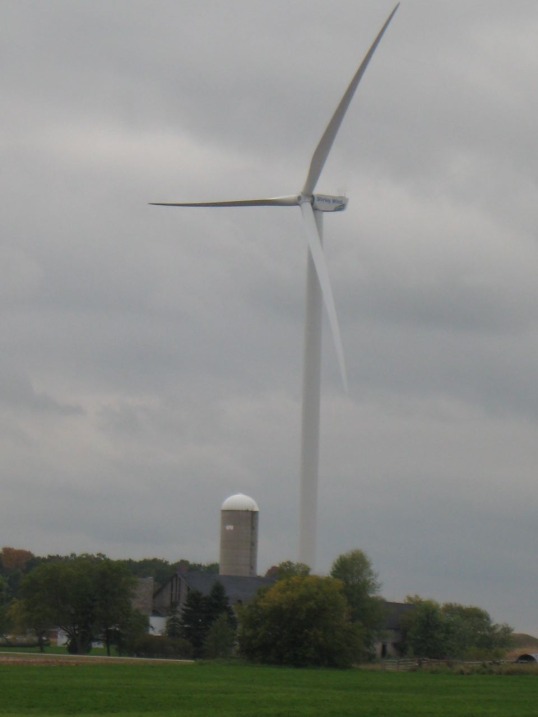
At 500 feet, the turbines going up in the Town of Glenmore in Brown County are the tallest in the state. Those in the wind industry continue to insist the presence of wind turbines has no effect on property values.
ACCIONA ENDS PLANS FOR WIND FARM IN MAGNOLIA
October 4, 2010
By Gina Duwe
MAGNOLIA TOWNSHIP — Plans that once called for up to 67 wind turbines dotting the countryside of Magnolia Township have ended.
An official with Acciona, a global energy company, confirmed that it has decided not to develop the EcoMagnolia project.
“That’s a case where I think … it was not an adequate wind resource for us to commit our full development for the project area,” said Chip Readling, lead developer for projects in several states, including Wisconsin.
Data gathered from a meteorological tower that stood for about three years at County B and Highway 213 showed “the project did not align well with our business goals,” he said.
“(It was) just a matter of wind,” he said.
Acciona still owns the project rights.
Plans are not as certain to the north.
The met tower that’s been up for nearly two years in Union Township will be taken down after the corn surrounding it is harvested.
The company’s meteorological team will analyze the data gathered from that tower—at County C and Highway 103—and decide whether to pursue a project, Readling said.
“We think it’s certainly a site we want to continue to watch,” he said.
If the company decides to move forward, the next step would be putting up a taller met tower—262 feet tall—to record wind speeds at the height of a turbine hub.
Readling said the company had no timeline and was not to the point of having landowners sign contracts.
He also said he could not release any of the wind speeds from either of the met towers.
In 2008, EcoEnergy said the average wind speed was 14.7 mph, measured at 197 feet on the Magnolia tower. The average was for a year starting in April 2007.
EcoEnergy first started the development of the Union project to include three turbines west of Evansville with Wisconsin Public Power buying the power produced for sale to Evansville Water and Light customers.
Acciona bought the rights for the Union and Magnolia projects from EcoEnergy in 2007.
Lost in the shuffle of the sale was the town permit for the Union met tower. The permit expired last fall, and Acciona failed to renew it. The town and company settled on a $6,000 fine for being out of compliance. Acciona officials are finalizing paperwork to make the payment, Readling said.
Reaction
Tom Drew, the landowner who hosted the met tower in Magnolia, said he hadn’t heard anything from the company since spring.
The plan to end the project was news to him.
He had not signed any contracts beyond the met tower, he said, and wasn’t really disappointed about the project not moving forward.
“To me, it was just nice clean energy,” Drew said. “That part is what I looked at. I never thought it would be any big windfall for anybody.”
When the project first started, his wife, Laurie, worked part time for about 18 months for EcoEnergy, setting up the company booth at events. She said she did it “to get a pulse on the company.”
Spring Valley resident Lynda Kawula doesn’t find relief in Acciona’s plan for Magnolia. Kawula and her husband, Kevin, live on the township border and feared having to move if turbines went up too close to their house.
“I don’t think it’s over yet,” she said.
Her research about wind turbines led her to start a website, betterplan.squarespace .com, advocating against wind farms that are sited too close to residents.
“If they could get these things sited correctly, everybody would come out happy,” she said.
Since the development plans emerged, the Kawulas have become engrossed in local and state government, have followed and taped the meetings of the state wind siting council’s rule-making process and visited with residents living on wind farms.
She plans to write a book about the wind industry in Wisconsin.
She has spent 10 nights in three different locations among two wind projects in the state.
“The relief part is funny,” she said. “Because I’m so tied up with people who are living with the turbine (problems) now, even if it’s not coming here right now, I’m still concerned about them and the little help they’re getting.”
WIND FARMS CAN CHANGE THE WEATHER
October 4, 2010
By Doyle Rice
Large wind farms can influence local air temperatures, according to a new study published today in the Proceedings of the National Academy of Sciences.
The data was collected over seven weeks in the summer of 1989 at the San Gorgonio wind farm near Palm Springs, Calif.
The study revealed that the wind farm caused the local area to cool down during the day and warm up at night, according to authors Somnath Baidya Roy and Justin J. Traiteur of the University of Illinois.
For instance, on one day of the study, the temperature at 1:00 p.m. upwind of the wind farm was about 100 degrees, but was about 93 degrees downwind, due to the effects of the windfarm.
The authors theorize that the turbulence generated by the turbine rotors, which can enhance the vertical mixing of warm and cold air, led to the temperature changes.
"To the best of our knowledge, this is the only meteorological field campaign conducted in an operational wind farm," the authors write in the study. "The wind farm consisted of 23-meter-tall turbines with 8.5-meter-long rotor blades arranged in 41 rows that were spaced 120 m apart."
Because many wind farms are located on agricultural land, the scientists say, local weather changes can affect crop productivity.
And what can be done? "The impacts of wind farms on local weather can be minimized by changing rotor design or by siting wind farms in regions with high natural turbulence," the study found. "Using a 25-year-long climate dataset, we identified such regions in the world. Many of these regions, such as the Midwest and Great Plains in the United States, are also rich in wind resources, making them ideal candidates for low-impact wind farms."
The authors add that "wind power is on the verge of explosive growth, most of it being in the industrial sector consisting of large wind farms."
As USA TODAY reported last year, wind projects are being proposed near the Texas Gulf, the Atlantic Coast, the Great Plains and Upper Midwest.
President Obama said in April 2009 that he would allow turbines along the Atlantic as one way to help meet a goal by environmentalists and the industry of generating 20% of the nation's electricity through wind by 2030. Currently about 1% of U.S. power comes from wind, according to the American Wind Energy Association.
8/13/10 DOUBLE FEATURE: Like a bad neighbor, Acciona is there. And ignoring noise studies AND Wind Farm Strong Arm: Wisconsin looks in the mirror and sees Maine:
Note from the BPWI Research Nerd: Spanish wind giant, Acciona, owns easements to land in Rock County for a large wind project that would occupy Magnolia Township. The proposal is for 67 wind turbines to be sited in Magnolia's 36 square miles.
Acciona has not responded to repeated email from Better Plan asking for information about the project.
The contracts held by Acciona for farmland in Rock County were solicited by a "local" wind developer, EcoEnergy, who wooed local residents, held contract signing parties and open houses and then quickly 'flipped' the project to Spanish ownership. How much EcoEnergy made by selling the valuable contracts is unknown, but the farmers who signed away their land won't see any of it.
Like a bad neighbor, Acciona of Spain is there.
Acciona submits 'final' statement; Developer ignores consultant's views on noise analysis
SOURCE: Watertown Daily Times, www.watertowndailytimes.com
August 12, 2010
By Nancy Madsen
CAPE VINCENT — The developer of St. Lawrence Wind Farm has eliminated two wind turbines for noise and wetland considerations, but it ignored the conclusions of the town’s consultant on noise analysis in order to maintain a 51-turbine array.
Acciona Wind Energy USA submitted the possible Final Environmental Impact Statement to the town Planning Board on July 28. The board will meet at 7 p.m. Wednesday at the Cape Vincent Recreation Park, 602 S. James St., to decide whether to accept the statement and deem it complete.
The developer’s consultant, David M. Hessler of Hessler Associates Inc., Haymarket, Va., maintained that his handling of noise measurements and analysis were proper. But the town’s independent consultants, Gregory C. Tocci and William J. Elliot of Cavanaugh Tocci Associates, Sudbury, Mass., found fault with the analysis.
Mr. Hessler used sound levels that were an average of 44 decibels during the summer and 37 decibels during the winter when the wind is blowing.
According to a state Department of Environmental Conservation guideline, noise exceeding six decibels above ambient is considered intrusive or objectionable. Hessler Associates’ analysis showed the array of turbines would not create noise above six decibels above ambient at any residence.
“All residences, whether participating or not, lie outside of the 42 dBA sound contour line and will be short of the 6 dBA NYSDEC threshold,” the developer wrote in the statement. “However, wind and weather conditions (i.e., temperature inversion and low level jetstreams) may develop from time to time causing Project sound levels to increase, sometimes substantially, over the normal predicted level.”
Those periods should be short, the statement said, although it noted that the cumulative effects if both St. Lawrence Wind Farm and BP Alternative Energy’s Cape Vincent Wind Farm were built would push noise levels above the DEC guideline. The statement predicted higher levels for six participating and 37 nonparticipating residences.
In letters to town engineer Kris D. Dimmick, of Bernier, Carr & Associates, Watertown, Mr. Elliot and Mr. Tocci repeated criticism of the noise analysis Mr. Elliot described to town officials in February. He said then that Hessler’s data did not statistically support the correlation between wind speed and noise. To get a stronger correlation, the wind speed and noise levels would have to be taken at the same location, but they were not, he said.
In a May 14 letter, the two disputed the background noise levels that Mr. Hessler assumed through his regression analysis. Mr. Elliot and Mr. Tocci had measurements that averaged five decibels below the levels Mr. Hessler predicted in his regression analysis. They recorded the sound levels at specific wind speeds.
If ambient noise levels have been overstated in the impact statement, it will allow higher levels of noise from turbines without violating DEC limits.
“Using a regression to associate background sound with wind speed frequently underestimates wind turbine noise impact by permitting frequent conditions where turbine sound significantly exceeds the NYSDEC margin of 6 dBA,” Mr. Elliot and Mr. Tocci wrote.
In a rebuttal letter June 21, Mr. Hessler said the actual measured noise values were too strict.
“Using these overly conservative values in the various wind speed bins as bases for evaluating the nominal impact threshold of a 6 dBA increase would undoubtedly and unrealistically suggest that adverse noise impacts will occur on a widespread basis over the entire project area and beyond,” Mr. Hessler wrote.
In a July 15 letter, Mr. Elliot and Mr. Tocci again argued against using the regression analysis and for the actual measurements from wintertime.
Using the measurements “leads to an impact threshold based on the NYSDEC policy that is approximately 5 dBA lower than the impact threshold estimated by Hessler” at 13.4 miles per hour, they wrote. “It is at this wind speed that Hessler indicates the greatest potential noise impact may occur.”
They reiterated that the Hessler analysis does not show a “conclusive relationship” between sound and wind speed. As a result of the averages used by Hessler, Cavanaugh Tocci suggested instituting a resolution process for noise complaints.
The developer proposed a complaint resolution procedure. A written complaint from a resident or business would go first to the developer. Acciona would have five days to respond and if the developer couldn’t fix it, the complaint would be sent to a town designee for investigation.
Any testing would begin within 10 days of the report from Acciona. Test results would go to the plaintiff and town within 30 days. If the town Planning Board agreed the turbine violates permit conditions, the developer would mitigate it. If the plaintiff wasn’t happy with the resolution or it had been longer than 30 days and there had been no resolution, an appeal could be made to the complaint resolution board.
The board will have a member from the developer and the town and an independent consultant agreed upon by the developer and town. That member can change depending on the nature of the complaint.
The board has 30 days to hear the complaint and 30 days to render a binding decision.
Repeated complaints will trigger additional investigations only if the town determines the operational characteristics have changed since the first complaint.
The final statement also proposes eliminating two turbines for noise and wetland concerns, moving a turbine 2.9 miles and adjusting 10 turbines to decrease wind turbulence. It includes additional well, wetland and wildlife studies. Five segments of roads and 23 intersections will need improvements to handle the construction, and 31 of the 51 turbines will be lit with simultaneously flashing beacons, according to Federal Aviation Administration standards.
The statement also responds to all comments made by agencies and the public on the draft and supplemental environmental impact statements.
The statement is available at the Cape Vincent Public Library, 157 N. Real St.; Lyme Free Library, 12165 Main St., Chaumont, and Cape Vincent town clerk’s office, 1964 Route 12E. If it is accepted as complete, it will be available on Acciona’s website as well.
If the board deems the statement complete, it can complete its findings and end the environmental review after 10 days. The board has indicated that could happen Sept. 15. Other involved agencies, but not the public, also will weigh in with findings.
SECOND FEATURE:
WIND POWER LAW HASN'T RESOLVED DEVELOPMENT CONFLICTS
SOURCE: Maine Center For Public Interest Reporting, bangordailynews.com,
By Naomi Schalit, Senior Reporter
AUGUSTA, Maine — After proposing major changes to state law that would speed up the review of wind power projects, Gov. John Baldacci’s wind power task force members went one step further: They made a map.
Without the map, the law would just be a set of rules. The map was essential because it showed where wind turbines could go to get fast-track consideration.
The map designated all the organized towns and about a third of the unorganized territory as the state’s “expedited wind zone” where that speedy consideration of projects would take place. The task force also proposed to allow the Land Use Regulation Commission to expand the areas if applicants met certain standards.
How that map got drawn is not clear from the official record of the task force’s meetings. That’s because summaries for the last two meetings don’t exist, said task force chair Alec Giffen’s secretary, Rondi Doiron.
“Everyone was working straight out on getting the report done and no one had time to get the summaries done,” Doiron wrote in an email to the Maine Center for Public Interest Reporting.
But Giffen and others freely describe the map’s genesis: First, Giffen consulted with the developers’ representatives one-by-one, as they were loathe to share proprietary information with competitors. Then he went to the environmental groups and asked what areas they wanted to protect.
Then he came up with a proposed map designating expedited wind development areas.
“I integrated, based on what I knew about what areas were important for what kinds of uses, presented it to the task force and got concurrence that the way in which it was outlined made sense,” Giffen said.
Others describe the map-drawing process as a last-minute rush to get the task force’s report done in time for legislators to consider as they neared the end of a short session.
“There was a lot of ‘Here, here, here and here’ and ‘No, no, no and no,” during the map debate, said task force member Rep. Stacey Fitts, R-Pittsfield. “It changed several times.” Maine Audubon’s Jody Jones described the process as “I want this in, I want this out.”
Whatever the process looked and sounded like is lost to the public record because no minutes were taken or recorded.
And that, says Sun Journal managing editor Judy Meyer, who’s also vice president of the Maine Freedom of Information Coalition, is “shocking.”
Maine law doesn’t require groups like the governor’s wind task force to memorialize deliberations, says Meyer.
“There’s no requirement that they record their meetings or produce minutes,” she says. “What smells particularly about this is that there are some summaries and not others. That’s a real eyebrow raiser. You’d think a governor’s task force would have the ability to keep minutes of its proceedings.”
Giffen says the map — which was approved by the full Legislature — is only the first step in deciding whether a project should be built in a specific place.
“It’s a coarse filter to try to get wind power development guided to parts of the landscape where it’s already partially developed and you already have infrastructure,” he said. “Then you have the finer filters of the regulatory process.”
Task force member Pete Didisheim of the Natural Resources Council of Maine, who was one of the group’s strongest proponents of wind power development, says the map provided an essential tool by taking a lot of uncertainty out of the process of siting wind farms. That’s because he says that the designation of expedited zones announced, by implication, where developers shouldn’t go.
“I don’t think that any other state has drawn a map that says to developers, ‘Don’t go here,’” said Didisheim.
Attorney Chip Ahrens, who attended task force meetings on behalf of two clients, a large wind power developer and an installer of small wind turbines in commercial and residential sites, said that approach turned state regulation on its head — appropriately:
“There had always been on the table the state saying where wind power should go,” said Ahrens, who stressed he was not speaking on behalf of his clients. “I said, ‘let’s say where it should not go.’”
And just because a site is in the expedited permit zone doesn’t mean it’s an automatic approval once a wind power project applies for a permit to build.
“The law specifically says that the permitting agency shall not compromise its regulatory review criteria,” says LURC director Catherine Carroll. “It’s not a slam dunk.”
Law tested, angering some
That point was made acutely clear this year in one of the first tests of the new law, an application by TransCanada to build turbines in the expedited wind zone near its western Maine Kibby Mountain project.
At a meeting on July 7 in Bangor, LURC commissioners — all of whom were nominated or renominated by Gov. John Baldacci — indicated by straw vote they’d deny TransCanada’s request to construct the turbines.
Several environmental organizations, including the three groups who were on the governor’s wind power task force, testified against portions of the project. Objections ranged from damage to wildlife to degradation of the scenically valuable high mountain site. Many of the commissioners likewise expressed concerns about the potential harm the project would do to the site.
Commissioners struggled to weigh the new law’s goals for wind power development against the environmental problems posed by the project.
“I’m terribly conflicted here,” said Commissioner Steve Schaefer.
He and other commissioners said they were unclear whether the law’s goals for wind power were binding on them and would force them to approve a project they didn’t feel protected the landscape they were legally obligated to protect.
“The Wind Power Act looms large here,” said Commissioner Ed Laverty.
“We’re all going to reduce global warming and our carbon footprint,” continued Laverty, “but most of the immediate benefits of projects like these do not accrue to the people of Maine, they’re exported through the grid elsewhere.
“What stays with us in the state of Maine are the environmental impacts.”
A few days after the LURC meeting, TransCanada’s project manager Nick DiDomenico was outraged at the meeting’s outcome. The environmental groups that had participated in the task force and then opposed TransCanada’s proposal drew his special wrath:
“The [environmental groups] were at the table when the map was drawn up,” he said. “That to me means these areas are acceptable for visual impacts. Maybe we were a little naive in drawing that conclusion.
“We thought the Wind Power Act meant something.”
Within eight days, construction company Cianbro’s chairman Peter Vigue had published a column in the Bangor Daily News criticizing LURC. Cianbro has done construction work on TransCanada’s wind power projects as well as others in the state.
“This unpredictable regulatory environment will discourage investment in Maine,” wrote Vigue.
On Aug. 1, retired law professor Orlando Delogu published a similarly sharp-toned column in the Maine Sunday Telegram.
“Reading a transcript of the recent LURC hearing on TransCanada’s proposed Kibby No. 2 wind energy project, a 45-megawatt expansion of an existing facility in Chain of Ponds Township, makes you want to cry for Maine’s economy and energy future,” wrote Delogu.
“And then it makes you mad.”
But state Sen. Peter Mills isn’t mad at LURC. Instead, he calls the LURC commissioners “victims” of a new state policy that isn’t clear enough about if, and how, competing values can be resolved.
“No one wanted to be bothered with the details,” said Mills. “We’ll just leave it up to LURC to figure out what we mean. We passed this thing, but we never gave them the tools to deal with this.”
LURC Commissioner Sally Farrand mirrored Mills’ frustration, when she remarked during the July 7 hearing, “Boy, I sure hope we can tighten up some of this stuff because I see it as a skating rink with some very dull skates.”
Other problems
There are other problems created by the legislation. One unintended consequence is that Maine mountain ridgelines, once available at relatively cheap prices to those who wanted to preserve them, have become coveted – and expensive – pieces of land.
“Were it not for the wind-power market, alpine land has fairly limited value,” said Alan Stearns, deputy director of the Bureau of Parks and Lands. “Right now the mathematics is land with wind power potential is not for sale for conservation.
“As long as the market for wind power is dynamic,” said Stearns, “most landowners with wind-power potential are working with wind power developers, not conservation groups, for that land.”
And turbine noise that irritates neighbors has proven to be especially problematic, with residents who live near towers complaining of sleep disturbance and other health problems.
But a comparison of the task force’s report with the governor’s legislation that became the Wind Power Act reveals a significant omission: The recommendation that the environmental protection commissioner be given the power to modify the noise aspects of a project’s permit never made it into the legislation.
Gov. Baldacci supplied the following answer in writing when asked why that provision had been left out of his wind power legislation:
“I relied on the Task Force members’ review of the draft legislation as a complete and accurate reflection of all the recommendations in their Report. If one or more of their recommendations was not included, I was not aware of that nor was any omission or deletion done at my request or direction.”
Task Force Chairman Giffen likewise had no idea how the omission occurred, and told the Center he knew of no plans to correct it.
Finally, the building of enormous, high-voltage transmission lines that the regional electricity system operator says are required to move substantial amounts of wind power to markets south of Maine was never even discussed by the task force – an omission that Mills said will come to haunt the state.
“If you try to put 2,500 or 3,000 megawatts in northern or eastern Maine — oh, my god, try to build the transmission!” said Mills. “It’s not just the towers, it’s the lines — that’s when I begin to think that the goal is a little farfetched.”
Uncertain future
What’s significant for the state’s wind power policy is that Mills, who wasn’t on the task force, isn’t the only one who now doubts whether the state can — or should — meet the goals promoted by the governor and enshrined in his Wind Energy Act.
Members of Baldacci’s hand-picked task force are dubious as well about whether there really are enough suitable — and politically acceptable — sites to build turbines to meet the goal of 2,000 megawatts by 2015 and 3,000 megawatts by 2020.
“We have to look at whether we have the land base to meet them,” said Jones.
Reaching 3,000 megawatts “is dependent on whether the political consensus holds up,” said task force member and DEP Commissioner David Littell.
“I think it’s a stretch to reach 2,000 by 2015,” said the NRCM’s Pete Didisheim.
But Giffen said he still believes that promoting wind power is an essential response to global warming.
“So big picture here, the way that I look at this, is to say, the idea that there’s not going to be any change in the state of Maine as regards our natural resources or how we generate energy, that’s not a possibility,” said Giffen.
”If we don’t do anyting, we’re going to see massive changes just in our natural resources. The changing climate conditions are going to mean that in 100 years the area around Portland is going to be suitable for loblolly pine (a southern tree species). What does that mean for our existing soils, our existing ecosystems?
“Is no change something that is even possible?” asks Giffen. “No, it’s not. Do we have significant problems with our energy supply and dependence on fossil fuels in terms of climate change? Yes.
“So is Maine well served by having looked at its regulatory system to see how it can deal in a rational way with this kind of development? Is it perfect? I doubt it. Will we learn as we go along? Yes.”
LURC Commissioner Laverty takes another perspective:
“I think we need to take into consideration, there aren’t a lot of these 2,700 plus foot mountains in the state of Maine … I think that we have to pay special attention to the impact on significant resources in these areas, because,” he said, “once you invade these resources, the chances of re-establishing them over time, at least in our lifetimes, probably are fairly slim.”
In the end, the law that was supposed to put conflict to rest has not, and for a host of reasons, both procedural and substantive. Harvard University professor Henry Lee, who teaches energy and international development at the Kennedy School of Government, said the conflict in values that wasn’t resolved by Maine’s Wind Energy Act — where those who want to act against the threats of global warming fight land conservationists — is one that’s playing out across the nation and globe.
“I think that this pits to some extent environmental organizations against each other,” said Lee. “Some are focused on pollution issues and see wind and solar and other renewables as a significant improvement in terms of reduced pollution — and it is.
“On the other hand if you’re worried about land use, in a world where … you have a finite quantity of land, there will continue to be significant disputes,” said Lee. “Wind sites tend to be slightly better along the coast and at higher altitudes, exactly where you have sign conflicts with esthetics.
“These disputes are going to get more intense, not less,” Lee said.
4/12/10 Why aren't the turbines turning? Why is the road repair undone? Why are the landowners mad? And why won't the project developer answer inquiries from Rock County?

Jeff Hammond, project developer for Acciona, said residents may have noticed that EcoGrove's turbines are not turning all the time. This is because there are many days when the wind is not strong enough to turn the blades and generate power, he said. ...Stephenson County Engineer Chris Isbell said there are two or three damaged roads in West Point Township and Winslow Township that were used for hauling equipment to EcoGrove during construction.
Company officials have also cleared up some of the rumors circulating about EcoGrove not being operational, and area landowners not being satisfied with their financial arrangements.
Jeff Hammond, project developer for Acciona, said residents may have noticed that EcoGrove's turbines are not turning all the time. This is because there are many days when the wind is not strong enough to turn the blades and generate power, he said.
Also, the EcoGrove farm was off line from March 22 through a portion of March 27, as part of a scheduled outage, Hammond said. The purpose of the outage was to allow ComEd crews to move a transmission line in the area to make way for highway construction work, he said.
"The wind power was off (during that time)," Hammond said of the outage. "It was a normal process. We don't like it, but sometimes we have to do it. It's back on now, but the wind hasn't been strong enough sometimes to generate power."
The EcoGrove wind farm outside Lena began generating power in July 2009. Local officials hope this project and others will place Stephenson County on the forefront of a renewable energy revolution in Northwest Illinois.
The farm was dedicated in September 2009, and organizers say the facility will be able to deliver enough energy to power up to 25,000 homes. The 100.5 megawatt wind farm is phase one of a three-phase project being pursued by Acciona in this area.
Recently, there have been rumors that certain landowners are dissatisfied with the money they've received from Acciona for use of their property. Hammond said landowners received their initial payments in late January, based on the power that was generated by EcoGrove from July to December.
According to Hammond, some landowners were confused by the payment schedule and expected to receive their checks in December. In addition, a few landowners were upset because they thought their payments would reflect a whole year of operations, not just half a year, Hammond said. These concerns have been addressed, he said.
"One or two people did not understand the payment schedule," Hammond said. "We're also cleaning up some crop damage. Everything is going very well. ... Long story short, all the landowners have been paid and all the questions that came up with that have been addressed."
Road Work
Some of the township roads in Stephenson County that were used by Acciona to deliver equipment to the EcoGrove site have been damaged, and still need to be repaired, Hammond said. As part of an agreement with the county, Acciona will be responsible for funding these repairs.
First, however, the county and townships will make their own repairs on the roads in question, before the wind farm damage is addressed, Hammond said. Negotiations regarding these repairs are ongoing, he said.
"As part of developing the wind farm, we agreed to upgrade and repair the roads as we use them," Hammond said. "We did that with the vast majority of the roads, but there is a set of crossroads that still need repairing. ... We are going to finalize the scope of the repairs we're responsible for. The delay has been in getting the final agreement done."
Negotiations Continue
Stephenson County Engineer Chris Isbell said there are two or three damaged roads in West Point Township and Winslow Township that were used for hauling equipment to EcoGrove during construction. Negotiations involving Acciona, the county, and the townships had been delayed for a while, but are now moving forward once again, he said.
"We're still in negotiations with them over the work that needs to be done, and the timing of that work," Isbell said. "Negotiations had been stalled for a little while, but they have been renewed."
Hammond said Acciona is dedicated to keeping up its end of the bargain for road repairs.
"The wind farm has invested a considerable amount of money in repairing and maintaining the roads," Hammond said. "I think that speaks volumes of Acciona's commitment to the county. ... I'm hoping we resolve this and can make an agreement by the end of this month."
Next Phases
Meanwhile, phases two and three of Acciona's Stephenson County initiative are still in the planning stages. Phase two, known as Wolf Creek, is planned as a 116-turbine wind farm in Stephenson and Jo Daviess counties, and will likely begin construction in 2012, Hammond said.
Organizers had hoped to begin work on phase two next year, but the recent economic downturn has slowed things down somewhat for large-scale wind farm projects in the U.S., Hammond said. The economy is now looking up, however, and Acciona officials are hopeful the second phase will be underway soon, he said.
"Wolf Creek is going along very well," Hammond said. "We think it will be a good project, but the build schedule is for 2012."
The third phase, Otter Creek, will be built just north of Dakota and is still in the preliminary planning stage. Hammond declined to comment on the possible size of Otter Creek, but said organizers hope to build it "right after" Wolf Creek.
"We are still evaluating Otter Creek," Hammond said. "That's still percolating at this point."
8/13/08 Rock County Residents Report Back on their Visit to Fond Du Lac County Wind Farm
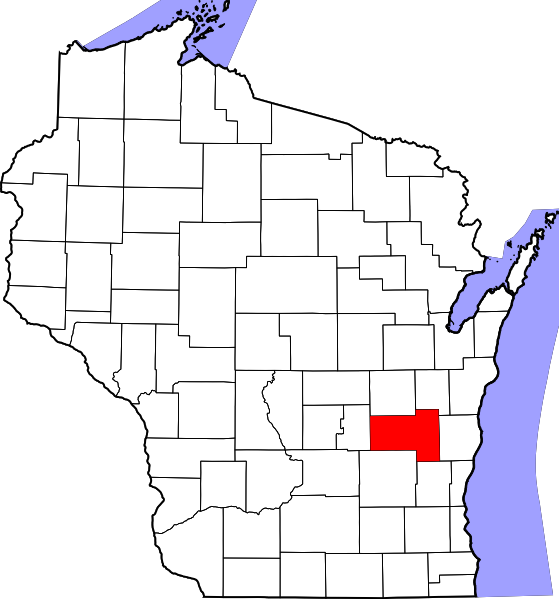 To see what the future could look like and sound like here in Rock County, you don't need a crystal ball. You just need to head north by north east about a hundred miles, to Byron, Wisconsin, in Fond du Lac county, where the Invenergy wind farm has been in operation since March 3rd. Residents of our area did just that and share their experience with us here.
To see what the future could look like and sound like here in Rock County, you don't need a crystal ball. You just need to head north by north east about a hundred miles, to Byron, Wisconsin, in Fond du Lac county, where the Invenergy wind farm has been in operation since March 3rd. Residents of our area did just that and share their experience with us here.
The map below shows the locations of the 86 turbines that make up the wind farm. Each red dot represents a turbine that is forty stories tall and has a wing span wider than a 747. There is only one building in the state of Wisconsin that is taller than 40 stories and it's in Milwaukee.
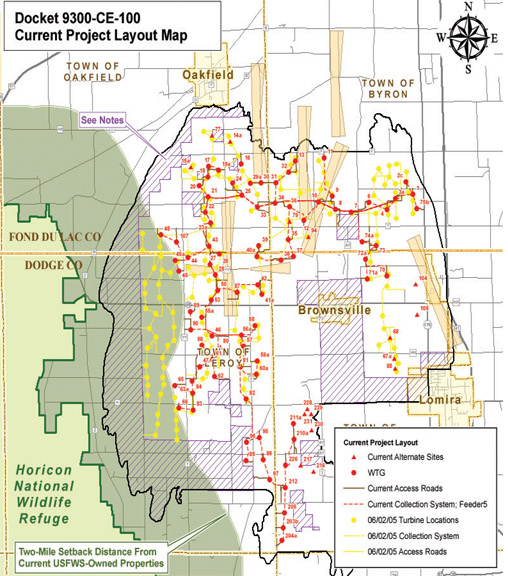

 The changes these machines have brought to those must live with them have been unbearable for many, Those who are getting money to host the turbines have an easier time putting up with the noise they make. For others, however, the change has been devastating. Though wind developers downplay the issue of noise it's the number one complaint for those who live inside of a wind farm. Since the turbines went on line in March of this year, for many families in Byron, their peaceful days and quiet nights are gone.
The changes these machines have brought to those must live with them have been unbearable for many, Those who are getting money to host the turbines have an easier time putting up with the noise they make. For others, however, the change has been devastating. Though wind developers downplay the issue of noise it's the number one complaint for those who live inside of a wind farm. Since the turbines went on line in March of this year, for many families in Byron, their peaceful days and quiet nights are gone.

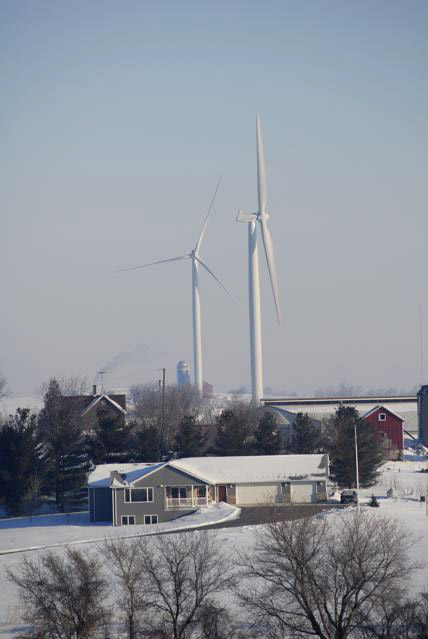
There may be a place for industrial machines of this size, but it is not 1000 feet from our homes and this is the reason Magnolia township adopted an ordinance which gives residents a safer setback of 2640 feet. (To download this ordiance, click here) There are those of us who believe even this isn't an adequate setback to protect our community, but it's better than the 1000 feet the developers want to force upon us. Unless your township has an ordinance this is just what they wil do. (To read a day-by-day noise log kept by a family living in this wind farm click here)We thank the Rock County residents who traveled up to Byron for sharing this report with us here. The photos below were taken during the winter during another Rock County resident's visit.

Visit to Byron Wisconsin to view existing Wind Turbine Facility.
Our trip to Byron was on June 6 and 7 of 2008
We came prepared with a sound meter provided by the Evansville Police Department and a camera.
Once past Horicon Marsh area, which has a 2 mile setback for the migratory birds, you could see Industrial Wind Turbines wherever you looked. There are 86 in the area.
We started with a turbine located on a hill off the main highway.
This was located approximately 1000 feet off the road. It was a fairly windy day and all the turbines in this area were turning. The meter registered between 58 and 68 DBA from the roadway.
While at this location, a local sheriff stopped and asked it we needed assistance. We said we were just gathering information for our Township on the turbines.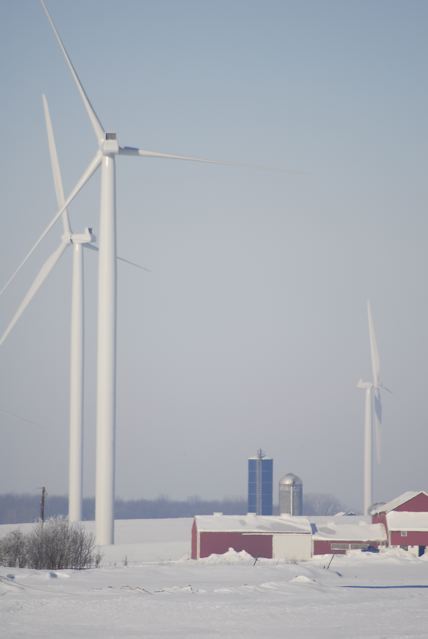 When asked what he thought about these, he stated he didn’t know anyone personally who had one but that they were definitely noisy.
When asked what he thought about these, he stated he didn’t know anyone personally who had one but that they were definitely noisy.
After he left, the farmer who owned this particular turbine came by. He was very open when we asked him questions concerning the turbine placement and the noise they created. He was accustomed to loud noise as he ran his corn dryer for 3 weeks straight in the fall and that was close to his home. He also stated you had to stay away from them in the winter due to the falling ice. You can really feel it when the chunks land around the area..
He was willing to put up with the noise, he had a daughter just entering to college and the extra money will help out.
His biggest concern was the roads.
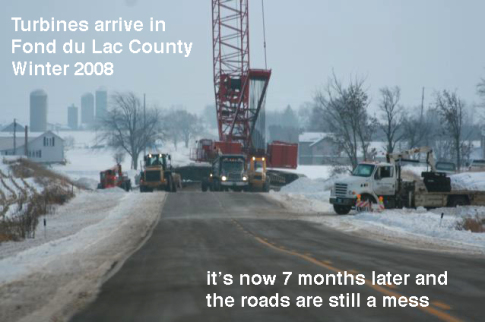
They were ripped up by all the heavy equipment and still hadn’t been fixed. He stated the town and the developer were arguing over who should fix then. There is a construction company in town, Michaels and he had hoped they would step up and do the repairs, but they wouldn’t do anything until they knew who would be footing the bill. This is another reason it is important to document the road conditions before the work begins and make it clear in the ordinance who will repair and in what timeframe it is to be completed.  Taking another road in the area we viewed a group of 3 turbines to the southwest of a home. The sound measurements here were between 58 and 64 DBA on June 6th. We stopped and spoke to the owners. They had attended all the informational meetings and still felt they were going to be too close to homes, but their township chose to ignore the concerns of the local residents. Shadow flicker was going to be a big concern in the winter months as the sun shifts and the shadow from these 3 turbines blanket this home. The flicker was currently only reaching their garden space but the sun was just about at its northern most axis. They were told at their meetings the size of the turbines would be smaller than what was ultimately installed
Taking another road in the area we viewed a group of 3 turbines to the southwest of a home. The sound measurements here were between 58 and 64 DBA on June 6th. We stopped and spoke to the owners. They had attended all the informational meetings and still felt they were going to be too close to homes, but their township chose to ignore the concerns of the local residents. Shadow flicker was going to be a big concern in the winter months as the sun shifts and the shadow from these 3 turbines blanket this home. The flicker was currently only reaching their garden space but the sun was just about at its northern most axis. They were told at their meetings the size of the turbines would be smaller than what was ultimately installed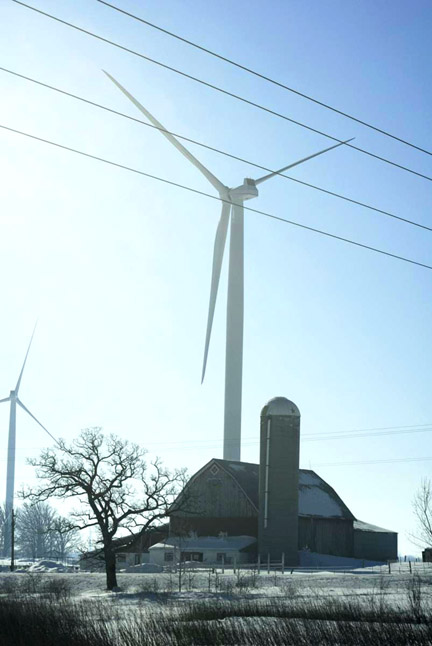
At the invitation of Gerry Meyer we visited his home. He lives at 6249 County Road Y, Brownsville WI 53006-1103 which is about ¾ of a mile East of South Byron. Turbine #4 is 1560 feet behind his house. Turbine #3a is about 500 feet mostly east and a little north of turbine #4. Turbine # 6 is about ¾ of a mile to the northwest of his home. Across the road mostly south and slightly west is turbine #73 and across the road at 2480 feet, down the hill to the west is turbine #74a which is about ¾ of a mile away. We could hear all of these turbines and the distance ranged from 1560 ft to ¾ of a mile. The sound was like driving down a highway with your windows down and passing another car, only you never get past them. The readings here were in a range of 59 to 67 DBA on June 6th and slightly lower on the 7th. 57 To 64 DBA.
Our draft ordinance suggested ½ mile as a starting point and this is too close for the health of local residents who would be living within this area to cope with 24/7 and 365 days a year for 30 years.
Stopping at the local convenience store we spoke to the cashiers. One woman said coming into the area at night was like coming into an airport with all the lights blinking. She stated the noise was much louder than the developers led the community to expect.
The young man, 16 years old, said he was just a kid and his opinion didn’t matter, but they made a lot of noise at night. His folks were not in favor of the short setbacks but again the township didn’t concern itself with protecting its residents.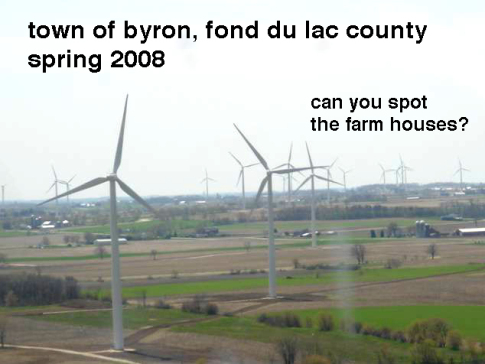 We traveled many of the roads in the area on both days, stopping wherever it was possible to take measurements. In all, we took readings of around 36 different turbines.
We traveled many of the roads in the area on both days, stopping wherever it was possible to take measurements. In all, we took readings of around 36 different turbines.
The lowest measurement was 48 DBA and the highest 69 DBA
We observed the condition of the roads all through out the “wind facility” and they were in poor condition. The corners were rounded and filled with large rock. The roadways were cracked and rutted. Driveways leading into the fields were everywhere and not always at a straight shot to the turbine. Hill and valleys dictated they go at an angle for visibility and this took up large chucks of the fields. 